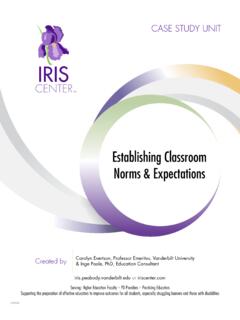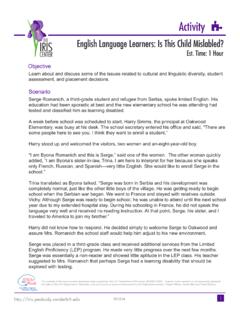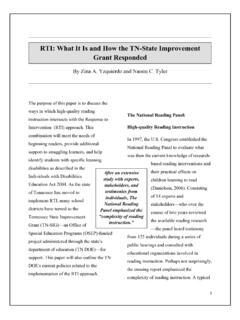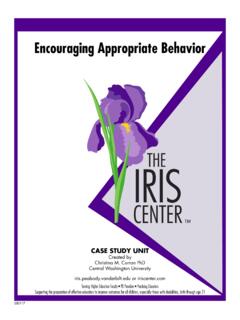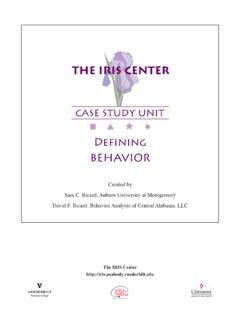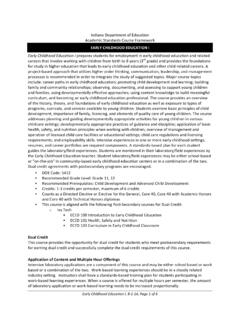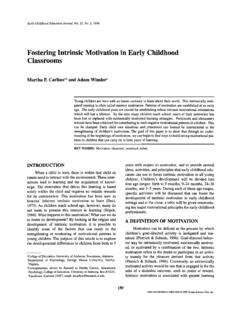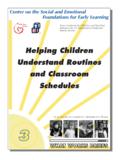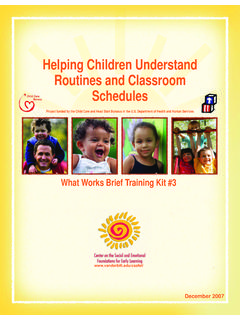Transcription of TE Early Childhood Behavior Management: R
1 Early Childhood Behavior Management: Developing and Teaching OutlineThe contents of this resource were developed under a grant from the Depart-ment of Education, #H325E170001. However, those contents do not necessarily represent the policy of the Department of Education, and you should not assume endorsement by the Federal Government. Project Officer, Sarah this outline to follow along with the module s main features. The blank Notes panels below each section are interactive and can be filled in using Adobe Acrobat. Otherwise, print this document and record your notes by Home Module Description: This module, a DEC-recommended practices approved resource, includes information on how to create developmentally appropriate Behavior rules for Early Childhood classrooms so that they link to a school s Behavior expectations. The importance of communication with families about rules and expected behaviors is also stressed (est. completion time: hours).
2 STAR Legacy Cycle Related to This Module Link: Module Outline Video: Navigating an IRIS STAR Legacy Module Link: IRIS and Adult Learning Theory Wrap-Around Content MapChallenge Video: Mrs. Rodriguez loves teaching preschool at Morningside Elementary School and takes great pride in her classroom. In addition to establishing her own classroom rules, she uses her school s approach to Behavior management , a color-coded system that she implements to visually indicate how each child is behaving on any given Thoughts Opinion: Do you think Mrs. Rodriguez s current Behavior management system is working? Explain. How can teachers help young children learn expected behaviors? How can teachers encourage and reinforce expected behaviors?NotesNotesEarly Childhood Behavior Management: Developing and Teaching OutlinePerspectives & Resources Module Objectives After completing the entire Perspectives & Resources section and reviewing the accompanying activities, you should be able to: Describe the importance of establishing classroom rules for young children that align with the Behavior expectations of the school Understand the guidelines for effectively developing and displaying rules for Early Childhood environments Identify different strategies for teaching and reinforcing rules for young children Describe the importance of communicating with families about rules and expected behaviors This IRIS Module aligns with the following licensure and program standards and topic Page 1: Preventing Challenging Behaviors in Young Children Early Childhood teachers identify children s challenging behaviors as one of the most difficult aspects of their jobs Audio.
3 Mary Louise Hemmeter talks about what teachers can do to prevent challenging behaviors in young children Research Shows Page 2: Understanding Behavior Expectations and Rules For most young children that is, those ages three to five school is a complex and novel setting Behavior Expectations Sample Behavior Expectations [bullet points] Rules This matrix illustrates how some Behavior expectations can be translated into rules for the classroom, playground, and hallway Audio: Amanda Peirick talks about the differences between Behavior expectations and NotesNotesEarly Childhood Behavior Management: Developing and Teaching Outlineclassroom rules Audio: Mary Louise Hemmeter adds some more thoughts about the differences between Behavior expectations and classroom rules, and further explains how establishing Behavior expectations and rules can help prevent problem behaviors before they happen For Your Information Revisit Mrs. Rodriquez s Classroom Page 3: Developing and Displaying Rules Once a teacher has identified the school s Behavior expectations, she Developing Rules Rules Link: developmentally appropriate [definition] Strategies for involving children in developing and introducing the rules [bullet points] For Your Information Rules should be developed for all settings relevant to the children Sample rules for a typical preschool settings Link: General Classroom Rules Link: Story time/Library Link: Music and Movement Link: Outside Playground Link: Art Center Activity: Mrs.
4 Rodriguez, the teacher in the Challenge, has eight classroom rules Link: See how we rewrote the rule and then compare your answer Displaying Rules Once the rules are Rule Link: Examples of visual supports based on the needs and abilities of children Did You Know? Audio: Amanda Peirick discusses developing and displaying classroom rules Revisit Mrs. Rodriquez s Classroom NotesEarly Childhood Behavior Management: Developing and Teaching Outline Page 4: Teaching Classroom Rules Developing and displaying rules is an important first step Link: intentionally and systematically [definition] Clearly Defining the Rules [bullet points] Involving Parents [bullet points] Link: Sample classroom rules book Reviewing and Checking Often [bullet points] Link: scripted stories [definition] Link: A scripted story for Bennett, who has trouble following directions Video: A teacher involves children in reviewing the rules and in demonstrating examples and non-examples Video: The teacher uses a large-group activity to evaluate children s understanding of the rules Providing Individualized Support [bullet points] Link: Example of additional visuals created for a child who has difficulty using gentle touches For Your Information Audio.
5 Amanda Peirick offers more information about teaching classroom rules Audio: Mary Louise Hemmeter shares additional thoughts about teaching classroom rules Revisit Mrs. Rodriquez s Classroom Link: think-pair-shares [definition] Page 5: Providing Rule Reminders Teachers can use several key strategies to encourage and remind children to follow the rules Link: Examples of precorrections for both a group of children and for an individual child Children should be acknowledged for following the rules during classroom routines and activities NotesNotesEarly Childhood Behavior Management: Developing and Teaching Outline Page 6: Providing Positive Feedback In addition to reminders, teachers should provide positive Feedback should Quotation The most powerful positive feedback is Behavior -specific praise or descriptive praise Examples Non-examples Did You Know? Research Shows Teachers can acknowledge individual or group progress [bullet points] Revisit Mrs.
6 Rodriquez s Classroom Page 7: Using Classroom Reinforcement Systems In addition to rule reminders and positive feedback, some teachers use a more structured approach For Your Information Link: Several reasons why a punishment-based system is not appropriate in Early Childhood classrooms There are two types of classroom reinforcement systems Sample rules poster On the other hand, some teachers might prefer an individual reward Tips for Teachers Several tips can help teachers make classroom reinforcement systems more successful [bullet points] Audio: Mary Louise Hemmeter discusses classroom reward systemsNotesNotesEarly Childhood Behavior Management: Developing and Teaching Outline For Your Information Link: positive behavioral interventions and supports (PBIS) [definition] Link: Center on the Social and Emotional Foundations for Early Technical Assistance Center on Social-Emotional Intervention (TACSEI) for Young Children Audio: Mary Louise Hemmeter describes the Pyramid Model that was developed collaboratively by CSEFEL and TACSEI Revisit Mrs.
7 Rodriquez s Classroom For Your Information Link: More information on addressing persistent challenging behaviors Page 8: Sharing Rules with Families Once teachers have established classroom rules, they Link: Sample letter to families regarding classroom rules Communicating and informing families about classroom rules Communication with families should occur regularly throughout the year Audio: Mary Louise Hemmeter talks about the importance of communicating with families of young children about Behavior expectations and classroom rules For Your Information Revisit Mrs. Rodriquez s Classroom Page 9: References & Additional Resources Suggested module citation References Additional Resources NotesNotesEarly Childhood Behavior Management: Developing and Teaching Outline Page 10: Credits Suggested module citation Content Experts Module Developers Module Production Team Media Production Team Media Expert InterviewsWrap Up Summary of the module Revisit your Initial Thoughts responsesAssessment Complete the numbered questions.
8 Please note that the IRIS Center does not collect your Assessment responses. If this is a course assignment, you should turn them in to your professor using whatever method he or she Childhood Behavior Management: Developing and Teaching Outline You Have Completed This Module Give Us Your Feedback Link: Module feedback survey form Professional Development Hours Link: IRIS PD Options Related Resources [links]Notes


